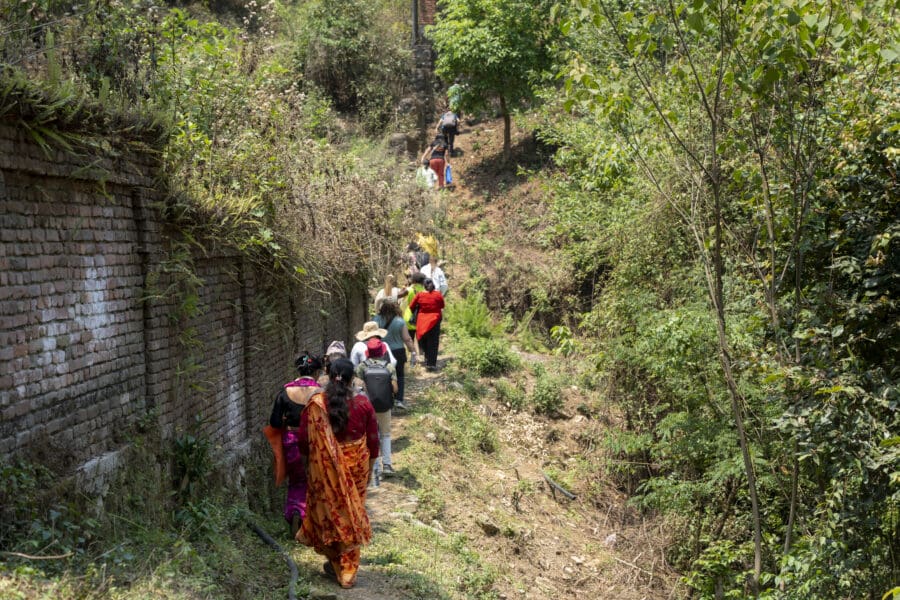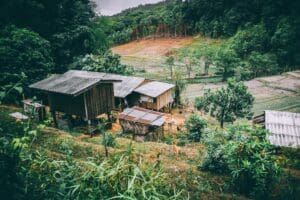Situated on Chandragiri Hill in Kirtipur, Nepal, about 12 km northwest of the capital city of Kathmandu, is the Champa Devi Forest and the Bagh Bhairab Forest. With no local support systems in place to protect the local environment, these forests were over-grazed by livestock and were so dry that forest fires often occurred.
To combat these problems, the Nepalese government turned over the management and protection of the forests to local groups called Community Forestry User Groups (CFUG). This was expected to reduce deforestation through direct, regional involvement.
Each CFUG is comprised of local community members and Indigenous Peoples who work together with the local government and non-governmental organizations to protect and conserve about 256 hectares of forest area.
To this day, each CFUG plays an important role in protecting the forests on Chandragiri Hill, but they didn’t begin to make significant progress in this quest until the women of these communities were allowed to join.

The impact of women in CFUGs
About a decade ago, the Federation of Community Forest Users, Nepal (FECOFUN), with assistance from Rights and Resources Initiative (RRI), began supporting programs in Nepal that focused on topics such as women’s empowerment and advocacy work. With the goal for CFUGs to be 50% women, and 50% of those women to be in decision making positions, these programs helped mobilize the women in the Chandragiri Hill area to join CFUGs and gave them the skills to be successful at advocating for the groups and protecting the forests.
“Earlier, we women were limited to household activities,” stated Yamuna Basnet, a current general secretary of the FECOFUN local chapter. “After joining the CFUGs, women were able to come out of their homes, attend social meetings, seminars, social events. Now, not just the forests, but even their leadership skills are being developed. The forest is well managed now only because women started managing it,” shared Basnet.
Some of the positive impacts that the CFUGs achieved after the women were trained and added to the groups include patrolling the forests on Chandragiri Hill, monitoring the tourists and locals who enter them, and organizing re-planting and shrub-clearing activities.
Basnet boasts about the shift that occurred once women were included, saying “only when women started working, then things started improving.”
Urmila Thapa, a member of Baag Bhairab CFUG, stated that now, to prevent forest fires, “we don’t allow people to smoke cigarettes in the forest, our community is alert to these incidents, especially when outsiders and tourists come to visit the forest.”
With changes such as these, the green cover began to return to the forests on Chandragiri Hill, and the area became popular for picnics, walking, and hiking. The number of thefts was also reduced, and, as the women in all the forest communities joined forces with the CFUGs, the forests acquired a well-managed and preserved look.
After seeing these positive changes, many families that had previously moved out of Kirtipur and to the city to earn a living decided to move back.
A sustainable source of new revenue
Through new environmental awareness and capacity-building activities, the local and Indigenous women also became instrumental in utilizing the forests to generate sources of income in a sustainable manner.
Since the women in the area were trained on how to sustainably collect raw materials from the forest floor to create briquettes, an alternative biofuel used for cooking and heating purposes, they started selling them.
Additionally, since tourists are drawn to the Champa Devi Forest area’s religiously significant temples, outdoor activities, and views of Mount Everest, CFUG members created hiking and cycling trails through the Champa Devi Forest and up to the Champa Devi Temple. This has helped entrance fee sales, which are used to fund labour to collect raw materials, keep the forests and trails clean, and patrol the forests.
The newly developed trails also serve as an agni rekha, or ‘fire-boundary’, acting as a line that can mitigate the spread of forest fires, should they occur.

Room for improvement
While training and integrating women into the CFUGs lead to great successes, Nita Basnet, the chairperson of the Champa Devi CFUG, shared that the current main concern of the CFUGs is a lack of funding. Their largest funding source is still the profits they make from selling raw materials gathered from the forest, and while entrance fees help, they are not enough.
When contemplating funding alternatives, one idea to utilize the skills of the women in the group came to mind. Medicinal plants and trees already grow naturally in the forests on Chandragiri Hill. The CFUGs could start an organized cultivation of medicinal plants and trees found in the forests and sell them at the ayurvedic hospital in Kirtipur.
Saraswati Khadka, a member of the Champa Devi CFUG, suggests that “the discussion and consultation process around this can include both men and women of the community, but it will be led by women.”
With the hopes of stronger funding, Khadka says “the money earned…will be used for vulnerable minority communities that are economically weak, like the Tamang, Newar, and Dalit communities, for their education and health needs.”
Looking forward
Overall, the combination of women having the opportunity to receive conservation training and the chance to join groups like the CFUGs helps Indigenous and local communities thrive. According to Khadka, “the key to bringing about change is to work collectively, as one unit.”
When considering how this could be applicable on a larger scale, Khadka says, “Women from other countries should come to our support, and we will come to theirs, only then there will be good results.” Thus, this experience in Nepal has shown that, to create lasting change, women must be given opportunities to contribute to their communities, and people must work together, men and women alike, on both regional and global levels.
To learn more about RRI’s regional work in Asia, click here!
Cover Photo: View from Chandragiri Hill. Credit: Chloe Ginsburg, RRI
Interested in receiving notifications about new blog posts? Subscribe to The Land Writes Blog now to get new posts delivered right to your inbox.




